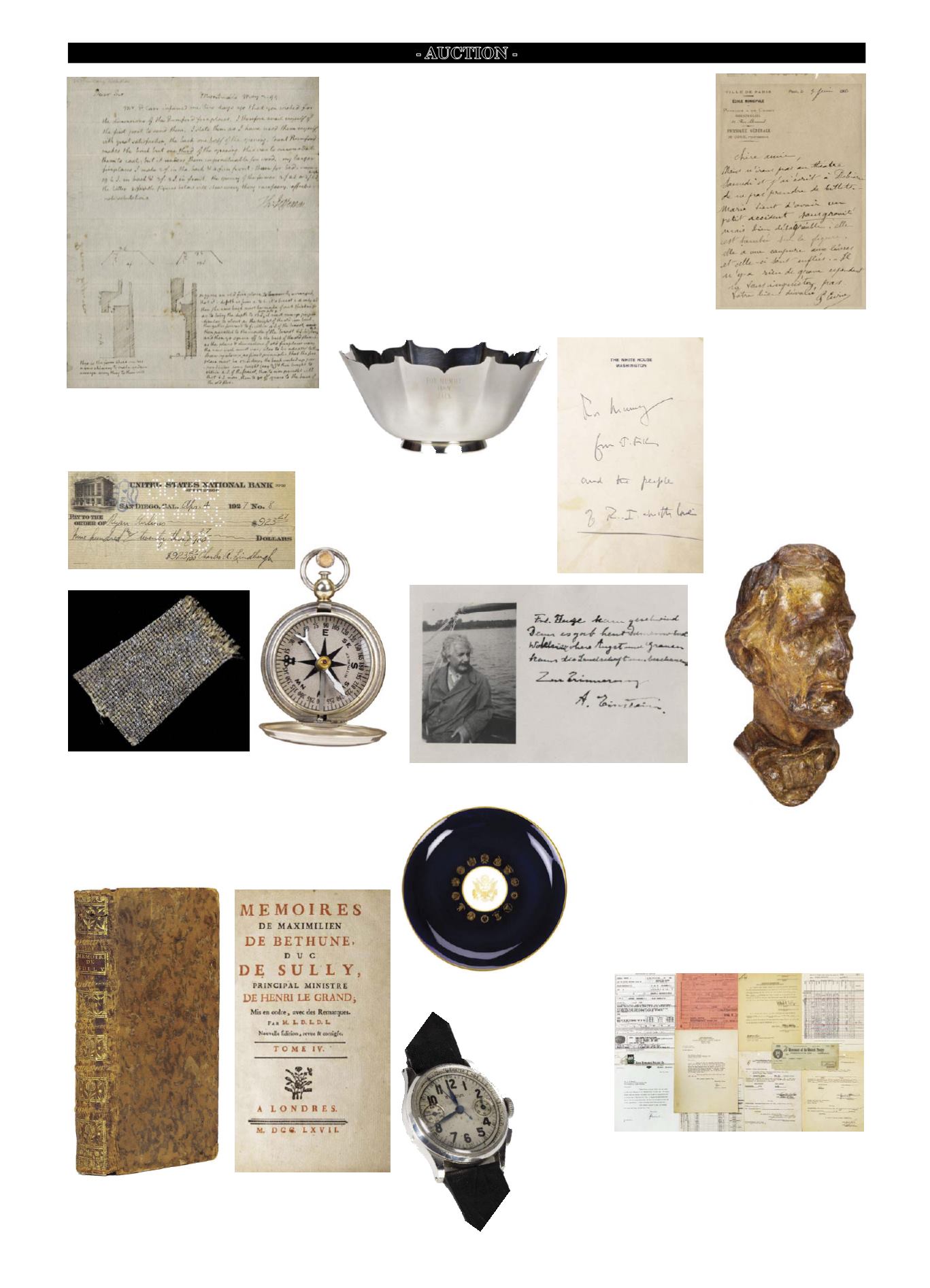

26-C Maine Antique Digest, April 2015
- AUCTION -
consignor to Profiles in History.
Among 20th-century highlights were
two unusual items relating to John
F. Kennedy. One was a cobalt-blue
dinner plate that fetched $7200 (est.
$3000/5000). The plate was produced
for a dinner of the Inter American Press
Association in honor of Kennedy. It was
held at the Hotel Americana in Miami
Beach on November 18, 1963—just
four days before the assassination in
Dallas. The buyer was the same private
collector who bought the Lincoln desk.
The same person paid $15,600 (est.
$10,000/15,000) for a silver footed
bowl by Gorham, inscribed “For
Mummy From Jack.” The bowl came
with an autograph note signed by
“JFK” on White House stationery. It
says: “For Mummy from J.F.K. and
the people of R.I. with love”—which
requires some explanation. “Mummy”
is Kennedy’s mother-in-law, Janet Lee
Bouvier Auchincloss. According to
JFK’s Last Hundred Days
(2013) by
Thurston Clarke, Kennedy received a
silver-plated vase from Rhode Island
Governor John Chafee as an anni-
versary gift. Kennedy thought it was
chintzy. He subsequently gave it to Mrs.
Auchincloss, calling it “a token of my
undying affection.” She didn’t get the
joke and thanked him, probably think-
ing it no less chintzy than had JFK, who
finally confessed where it had come
from. The beautiful bowl is believed to
have been a makeup gift for what can
legitimately be viewed as one of the
great “re-gifting” flops of all time.
For more information, contact Pro-
files in History at (310) 859-7701 or
see the Web site
(www.profilesinhistory.com).
An autograph letter signed by Thomas Jefferson while
vice president realized $72,000 (est. $60,000/80,000). The
subject of the one-page, approximately 10" x 8" missive,
which is addressed “Dear Sir,” is his idea for retrofitting
fireplaces in Monticello.
A one-page 8¼" x 5¼" autograph
letter signed by Pierre Curie sold
to an Internet bidder for $12,500
(est. $10,000/15,000). Written in
French on letterhead stationery,
it was dated June 3, 1903, the
year Pierre and Marie Curie won
the Nobel Prize in Physics. It was
addressed to “Chère amie”—an
unidentified correspondent—and
discusses an unserious fall Marie
had taken. It also mentions the
cancellation of the Curies’ the-
ater outing with André Debierne,
a French chemist who collabo-
rated with Marie in her work on
radioactivity.
A silver footed bowl by Gorham, inscribed
“For Mummy From Jack,” sold for $15,600
(est. $10,000/15,000). It is 3¾" high x 8"
diameter and accompanied by a John F.
Kennedy autograph note.
A $923.27 check signed by Charles A. Lindbergh to Ryan Airlines on
April 4, 1927, for instruments installed in the
Spirit of St. Louis
sold for
$30,000 (est. $25,000/35,000). The lot included a small pocket compass
presumed to have been used by Lindbergh and a swatch of silver fabric
skin from the famous plane. The fabric skin measures ¼" x ½". It came
from a larger (3¼" x 2½") piece that Lindbergh himself removed fol-
lowing the plane’s final flight to Washington, D.C., in April 1928, when
it went into the Smithsonian Institution’s collection.
An autograph poem byAlbert Einstein and a photograph of him,
both unpublished, 3½" x 5½", sold for $10,800 (est. $2500/3500).
A book from one of Thomas Jefferson’s libraries—the fourth volume
of
The Memoirs of the Duke of Sully
, in French—sold for $27,000 (est.
$20,000/30,000).
Gutzon Borglum’s painted plas-
ter cast of Abraham Lincoln as
depicted on Mount Rushmore sold
for $16,800 (est. $12,000/15,000).
It is 6" x 3" x 3". The lot includes
two smaller plaster casts, one of
Lincoln, the other of Thomas Jef-
ferson, as well as related paper
documents.
A cobalt-blue dinner plate, 10½"
diameter, sold for $7200 (est.
$3000/5000). It was pro-
duced for the dinner of
the Inter American Press
Association in honor of
JFK, held at the Hotel
Americana in Miami
Beach on November 18,
1963.
An archive of more than
130 items relating to World
War II U.S. Army Air Corps
Colonel Robert K. Mor-
gan (1918-2004) real-
ized $24,000 (est.
$20,000/30,000).
Morgan
com-
manded the legend-
ary B-17 bomber
Memphis Belle
in Europe as well as the B-29
Dauntless Dotty
in Japan. Besides
documents, letters, and other personal papers, the lot included a vintage Bulova
wristwatch engraved with the words “For Valor Capt. Robert K. Morgan Pilot
of the ‘Memphis Belle’ July 1943 A tribute from Ardé Bulova.” Ardé, the son of
the Bulova founder, was the company’s chairman of the board from 1930 until
his death in 1958. He worked with the U.S. government to produce military
watches, specialized timepieces, aircraft instruments, and critical torpedo mech-
anisms and fuses—at cost—throughout the WWII years.










